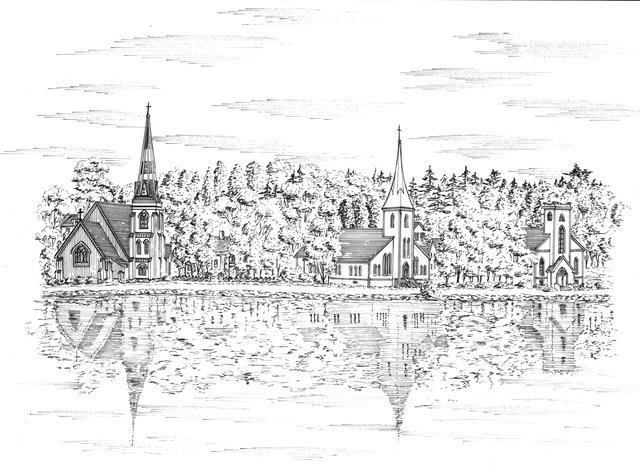
The Three Churches, Mahone Bay, NS
Scroll down for historical sketch
Signed & Matted Limited Edition Print 8" x 10"
$20 each. (plus shipping $4.)
Add the appropriate shipping charge and submit your order by email(gallery@eastlink.ca), giving us the destination postal address and your telephone number. We will respond promptly and notify you when your payment has been received and the tracking # for your parcel.
The Armstrong Gallery accepts payment for online orders by:
1. email-transfer of funds to gale@eastlink.ca (available within Canada)
2. Visa or Mastercard. Please email or telephone (902-640-2176) with the credit card particulars.
If ordering more than one piece of artwork we will do our best to combine the packaging to obtain the best shipping rate and will advise you accordingly as to the final charge.
YOUR PATRONAGE IS MUCH APPRECIATED…THANK YOU!
The Three Churches, Mahone Bay
The Mahone Bay Churches stand like spiritual beacons at the head of the harbour. The Presbyterian Church (now Trinity United) is the oldest, dating from 1861. Trinity Church was originally located on the hill by Bayview Cemetery and was moved to its showy position on the waterfront in 1885 in a ten-day ordeal that had the town’s undivided attention and cost the parishioners a very substantial sum of $800. By the time of the move waterfront property was getting pretty pricey, the Presbyterians had to pay $360 for their plot, while the St. John’s Lutherans got first position on “church row” in 1869 for a mere $64. St. John’s was replaced by the present building in 1903. Of the three churches, it is generally St. James’ (far left in the drawing) that receives the most attention. Perhaps this is because it was designed by the acclaimed architect, William Critchlow Harris, who specialized in churches and gave Nova Scotia seventeen of its finest gothic edifices. St. James, which was built in1887, is among Harris’ early churches and his winning the commission was probably not hindered by the fact that his brother was then curate of St. James. Harris’ ecclesiastical aestheticism was boundless, carrying over into his designs for residential properties, including the beauty I owned in Windsor when I drew this picture.

